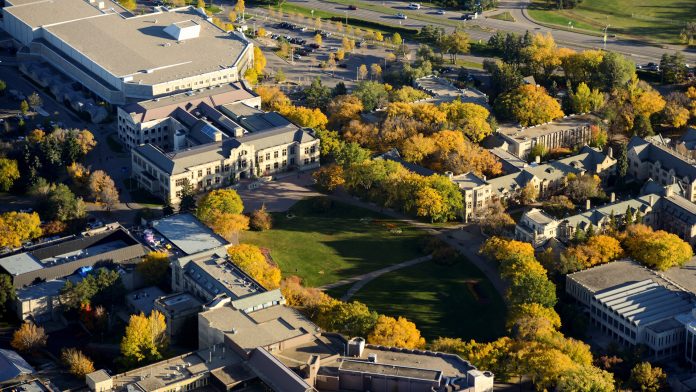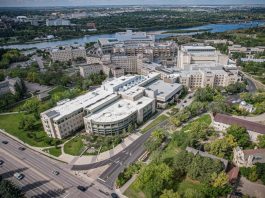Located in Canada’s Prairies, the University of Saskatchewan is at the cutting edge of research and innovation.
Innovation is the lifeblood of cutting-edge research, and the University of Saskatchewan (USask) is home to groundbreaking innovation – from the smallest subatomic particles, all the way to outer space.
World-renowned research hub
Situated in the heart of the Canadian Prairies, USask attracts researchers and scholars from across the world. Since its establishment in 1907, the university has been foundational to higher education in Saskatchewan and Canada – training world leaders in agriculture, health sciences, business, engineering, art, and more.
The main USask campus along the South Saskatchewan River in Saskatoon is home to world-renowned research facilities. The Canadian Light Source (CLS), Canada’s only synchrotron light facility, provides beamline research resources to USask faculty and national and international collaborators. The Vaccine and Infectious Disease Organization (VIDO) has been at the forefront of developing vaccines for humans and agricultural animals and played a major role in Canada’s COVID-19 pandemic response.
Major USask institutions, such as the Global Institute for Water Security (GIWS), the Global Institute for Food Security (GIFS), and the Sylvia Fedoruk Canadian Centre for Nuclear Innovation, have placed USask as a leader in providing both infrastructure and expertise needed to address modern-day questions around the world.
USask is also the proud home of the Gordon Oakes Red Bear Student Centre dedicated to Indigenous student achievement and cultural gathering. USask’s Indigenous Strategy was gifted to the university by Indigenous peoples from Saskatoon and Saskatchewan and was informed and developed by representatives of those peoples along with Elders and Knowledge Keepers.
Peter Stoicheff, President of USask, said: “USask researchers continue to develop new technologies to improve the lives of people around the world.
“The university’s many research and innovation strengths, including superb faculty and students and unique-in-Canada infrastructure, enable our mission to be what the world needs.”
In the 2023/24 fiscal year, USask set a record high in the university’s history by attracting C$417m in awarded research funding – showcasing the immense and continuing growth of its research landscape.
Baljit Singh (PhD), USask’s Vice-President Research, said: “This success is a testament to the researchers, staff, and faculty who have worked hard in our pursuit of innovation in the heart of Saskatchewan.
“The sky is truly the limit for both new and existing research, scholarly, and artistic work on this campus and in this province, and I am excited to keep this momentum moving forward into the years to come.”
Research for a better future
The university has identified nine key Signature Areas of Research as critical avenues for research, scholarly and artistic works that will catapult USask into the future. The Signature Areas are Agriculture, Communities and Sustainability, Energy and Mineral Resources for a Sustainable Future, Health and Wellness, Indigenous Peoples, One Health, Quantum Innovation, Synchrotron Science, and Water.
USask researchers are constantly creating and innovating. Below are just a few prominent examples:
Revolutionary robotics for remote healthcare
In a province as large and widespread as Saskatchewan, accessible healthcare is critical. USask researchers are pioneering new and innovative solutions for remote healthcare – solutions that will benefit populations around the globe.
Dr Ivar Mendez (MD, PhD) is internationally renowned for spearheading advances in virtual healthcare. A professor emeritus of Neurosurgery in USask’s College of Medicine and the Director of the Virtual Care and Remote Presence Robotics Programs, Mendez was appointed an Officer of the Order of Canada for his revolutionary telemedicine and robotics advances.
Mendez’s program at USask has expanded the use of robotics in healthcare throughout the province, Canada, and internationally. Telehealth systems implemented by Mendez and his team have allowed healthcare practitioners to deliver long-distance ultrasounds, provide critical mentoring for the treatment of medical emergencies in remote areas, and provide primary care to patients during the COVID-19 pandemic.
USask’s Virtual Care and Remote Presence Robotics Programs have become exemplary of creative healthcare solutions for remote care around the world, and USask researchers continue to devise new technologies with robotics, artificial intelligence (AI), and virtual connectivity to be what the world needs for modern healthcare.
Vaccine research for creatures large and small
USask’s VIDO facilities are uniquely suited for the development of new vaccines for both humans and animals as Canada’s Centre for Pandemic Research.
VIDO is Canada’s largest and most advanced Biosafety Level 3 Agriculture facility in Canada and is designed for the study and creation of illnesses and vaccines for livestock animals, placing the facility and its researchers at USask among the most advanced in the world for animal vaccine development.
During the heights of the COVID-19 pandemic, VIDO researchers led critical vaccine research and developed two Canadian-made COVID-19 vaccines.
But VIDO’s innovations are not limited to COVID-19. Researchers like Dr Angela Rasmussen (PhD) and Dr Alyson Kelvin (PhD) have received federal funding to study the highly virulent mpox (formerly referred to as monkeypox), both to better understand its transmission but also to develop therapeutics to treat the illness.
Canada is banking on the future of VIDO at USask as well, with the most recent federal budget committing C$30m to complete infrastructure developments to include large animal housing for vaccine testing and upgrading VIDO to containment Level 4.
Once completed, VIDO will be Canada’s only non-government containment Level 4 facility – a unique and incredible institution housed at USask.
Unlocking the wheat genome and advancing crop science
The Canadian Prairies are home to some of the largest and most advanced agricultural production in the world – and USask’s Crop Development Centre (CDC) is helping make Saskatchewan producers the most effective on the planet.
Part of the College of Agriculture and Bioresources, the CDC contributes to the research and development of crop varieties to meet the needs of growers and consumers across Canada and around the world. More than 500 commercially available varieties across 40 kinds of crops have been developed and released by the CDC since the institution’s start in 1971.
World-class researchers at the CDC are also taking the lead on worldwide projects with massive ramifications for food production and security. Dr Curtis Pozniak (PhD), Director of the CDC, led an international project which sequenced the genomes for 15 varieties of wheat, providing an invaluable roadmap for researchers and crop breeders around the world to breed wheat with improved yields and stronger resistances.
But it’s not only wheat where USask and the CDC are setting the standard. According to a recent economic report, crop varietals produced at the institute have led to billions of dollars and thousands of jobs for the Canadian economy.
USask is an institution producing revolutionary research, scholarly, and artistic works in the heart of Canada on behalf of the entire world – and the centres and faculty across USask continue to strive to be what the world needs.
Please note, this article will also appear in the 19th edition of our quarterly publication.





